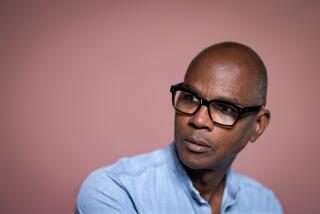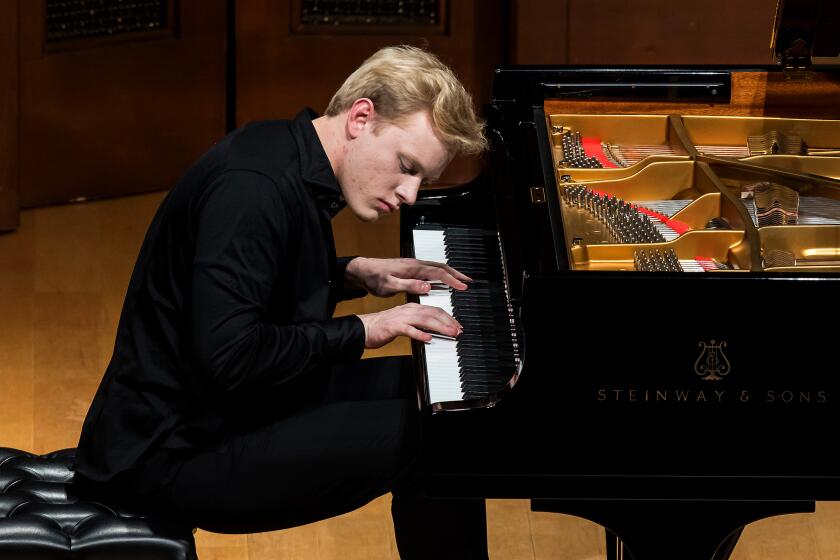Henry Moore, Renowned British Sculptor, Dies at 88
- Share via
Henry Moore, the British artist widely regarded as the greatest sculptor to emerge after World War II, died Sunday at the the age of 88 at “Hoglands,” his home at Much Hadham Hertfordshire near London.
The cause of death was not disclosed, but Moore had been in frail health for several years. Suffering from arthritis and diabetes, he was confined to a wheelchair.
In his youth in the 1930s, Moore’s work was inventive and controversial. His use of biomorphic kidney-shaped forms suggesting human figures with holes drilled through them seemed grotesque and became the prototype for cartoons satirizing “modern art.”
Meantime critics, connoisseurs and fellow artists held Moore in the highest esteem, regarding him as a protean giant who had single-handedly rescued 20th-Century sculpture from mediocrity in much the same way that Auguste Rodin had revitalized the form in the 19th Century. Like Rodin, Moore was so popular in the United States that insiders joked about which of them was the greatest “American” sculptor.
Moore, like other pioneer artists with long and productive careers, eventually became such a pillar of the establishment that the avant-garde came to regard him as an irrelevant maker of gigantic institutional “hood ornaments” for corporate plazas and entrances to cultural cathedrals. Dozens of public commissions were accorded Moore, who was a tireless worker even as his health began to fade in his 70s.
His best known works are massive outdoor sculptures, such as a bronze figure 30 feet wide and 16 feet tall in the reflecting pool at New York’s Lincoln Center for the Performing Arts, and the immense, rather over-scaled “Knife Edge Two Figures” punctuating the facade of the National Gallerys East Building in Washington.
His most recent large-scale U.S. exhibition was a retrospective at New York’s Metropolitan Museum in 1983.
In Los Angeles, significant examples are to be seen at the Norton Simon Museum and at UCLA in the Franklin D. Murphy Sculpture Garden.
Exhibition in L.A.
Moore, enthusiastically collected here, was seen in a large exhibition at the County Museum of Art in 1973 organized by former Times art critic Henry J. Seldis in conjunction with his book, “Henry Moore in America.”
Seldis, who died in 1978, was a longstanding friend of Moore’s and said of him: “Amid the clamor and despair reflected in so much of 20th-Century art, Henry Moore continues to confirm the significance and meaning of life.”
Both praise and criticism of Moore seem to perch on common themes that were the basis of his undeniable genius--continuity, earthiness, the virtues of modesty and hard work. (The artist routinely refused to be knighted.)
Henry Spencer Moore was born July 30, 1898, in the small town of Castleford. The son of a coal miner, he would grow to make art that appeared dredged from the primal substrata of the human subconscious.
He was the seventh of eight children and some of his most renowned and affecting work depicted couples, atavistic and regal, with their children, in homage to the family.
Doted on Mother
When his younger sister died, his parents indulged him as the youngest in the family. In later years he frankly acknowledged doting on his mother, Mary, and diagnosed himself as having a “mother complex.”
His art was full of archetypes but none was more persistent or predominant than that of the female figure, especially in a reclining pose. A Moore trademark, the theme was actually inspired by the Pre-Columbian rain god Chacmool from the Toltec-Mayan tradition, but Moore transformed the prototype. His figures, with their looping limbs and open spaces suggest roots, caves and hills and fuse the female image into a true Earth Mother figure.
Moore’s father had a determination to see that his children escaped the maw of the mine and “better their lot in life.” To that practical end, young Henry was enrolled to train as a teacher. But the son matched his father’s determination and also pursued the study of sculpture. In practice father and son were both right. Moore drew inspiration from teaching sculpture long after he needed supplementary income from his art career.
That career was interrupted for two years by World War I. Moore fought as a private in France, but he was gassed in the Battle of Cambrai and discharged in 1919.
Back to teaching, travel and making his own art, Moore discovered a wide variety of influences. He loved Renaissance humanism, Michelangelo’s marble carving and heroic scale. He liked to joke that, although he was rather diminutive at 5 feet, 6 inches, he was taller than either Rodin or Michelangelo.
Fascination in Shapes
Eventually he established an Italian summer home at Forti di Marmi near the master’s quarry at Carrara. He was fascinated by the shapes of organic objects from shells to bones and huge natural outcroppings of rocks. But the thing that clearly gave the young artist a way of putting it all together was his discovery--along with the rest of the art world--of primitive tribal art. The power of Pre-Columbian stone carving and the mystery and formal coherence of African helmet masks gave Moore the syntax of his visual language.
Where Picasso had mined primitive art to fuel his mythic ferocity and Matisse had found elegant hedonism there, Moore would use it as a foundation for his almost alluvial love of duration and basic tradition.
Moore married a fellow art student, the Russian-born Irina Radetzky in 1929 and never looked back. The artist was a good family man, adoring his daughter, Mary, and a grandson, nicknamed Gus, who inspired the old artist to portray him in affectionate, Rembrantesque drawings.
Until World War II, Moore was mainly an art-world artist. Probably the single most important factor in changing that was the London blitz. In the devastating bombings, Moore found himself in the underground shelters, where he drew ordinary people, swathed in blankets like Egyptian mummies, strangely vulnerable and yet enduring.
Change in Career
These so-called “shelter drawings” marked a shift in Moore’s career that was certainly reinforced by his permanent move to Much Hadham after his London studio was bombed. Thereafter he would be less formally rigorous, more humane and popular with an ever-expanding audience. The change is the Rubicon that separates Moore’s appreciators into two camps.
Moore’s reputation emerged from the rubble of the war with that of a generation of British artists that included Francis Bacon, Barbara Hepworth and Reg Butler and on the continent Alberto Giacometti and Jean Dubuffet. They formed the core of a new kind of Expressionist figurative art that was seen to reflect both the isolation of Existential post-war man and a new humanism.
Moore’s version of this sometimes agonized art was one of consolation and celebration.
In a recent interview he said: “I would like my work to be thought of as a celebration of life and nature.”
More to Read
The biggest entertainment stories
Get our big stories about Hollywood, film, television, music, arts, culture and more right in your inbox as soon as they publish.
You may occasionally receive promotional content from the Los Angeles Times.










